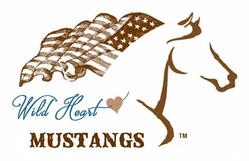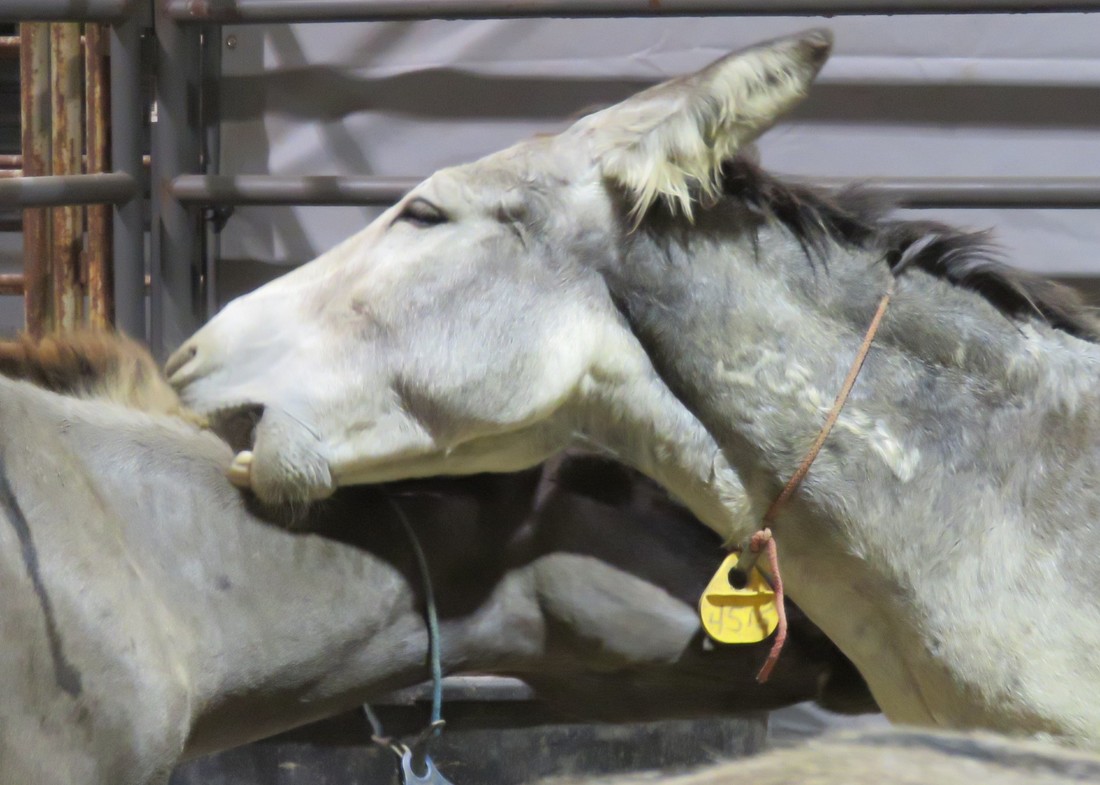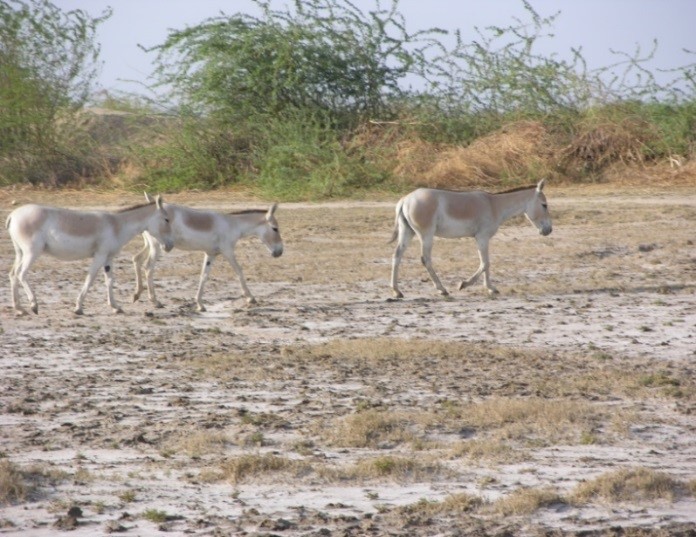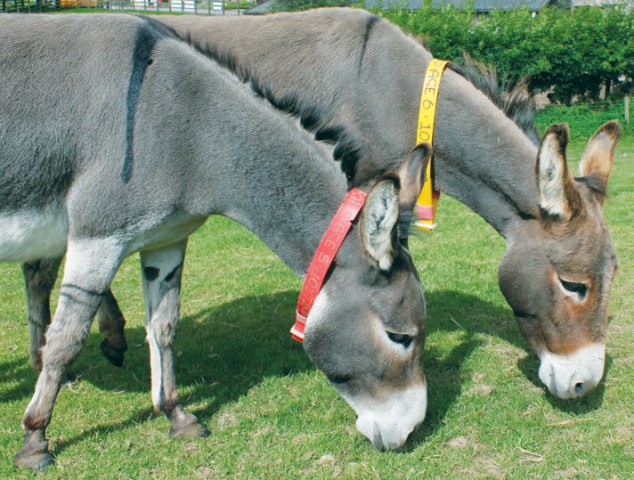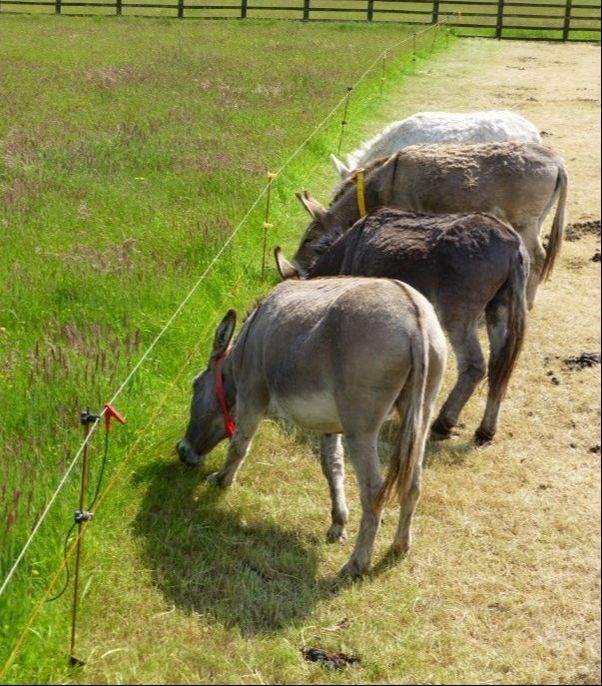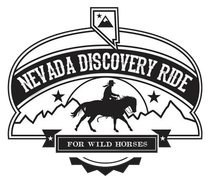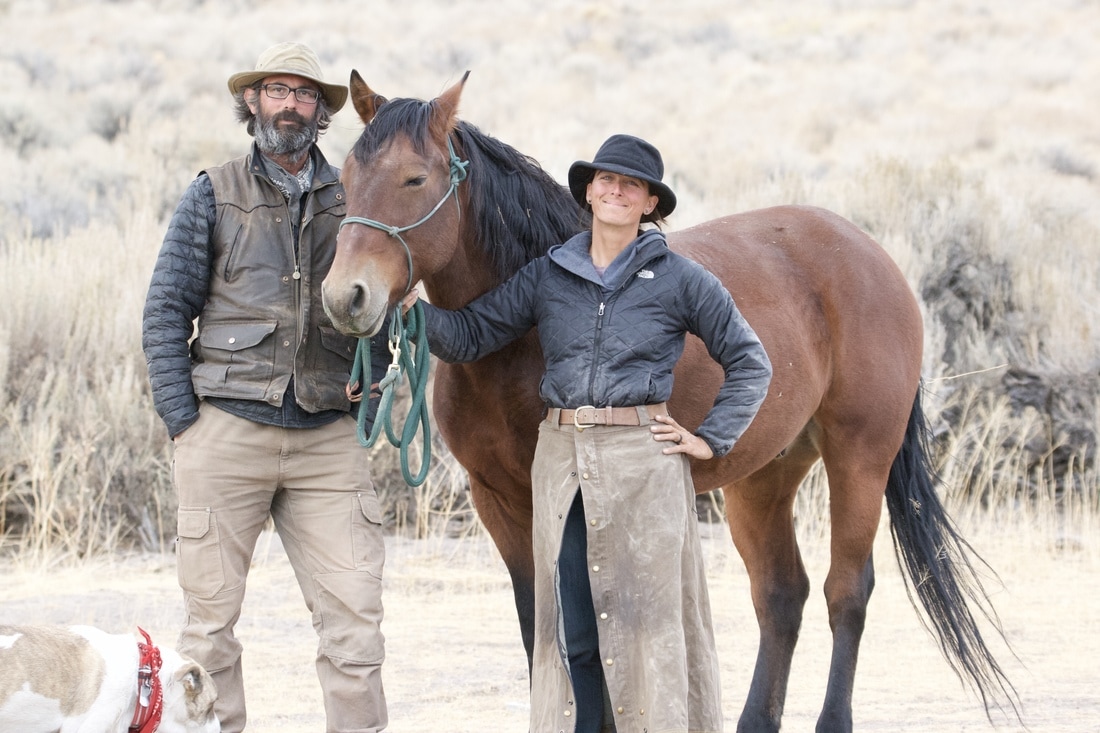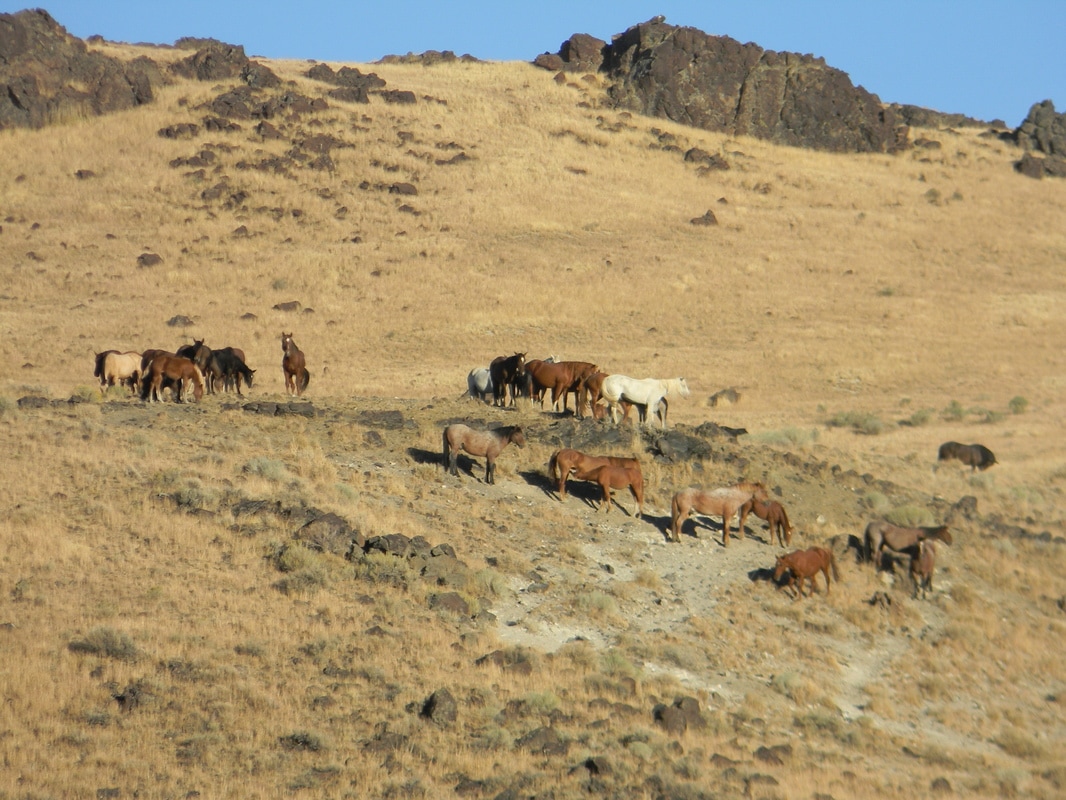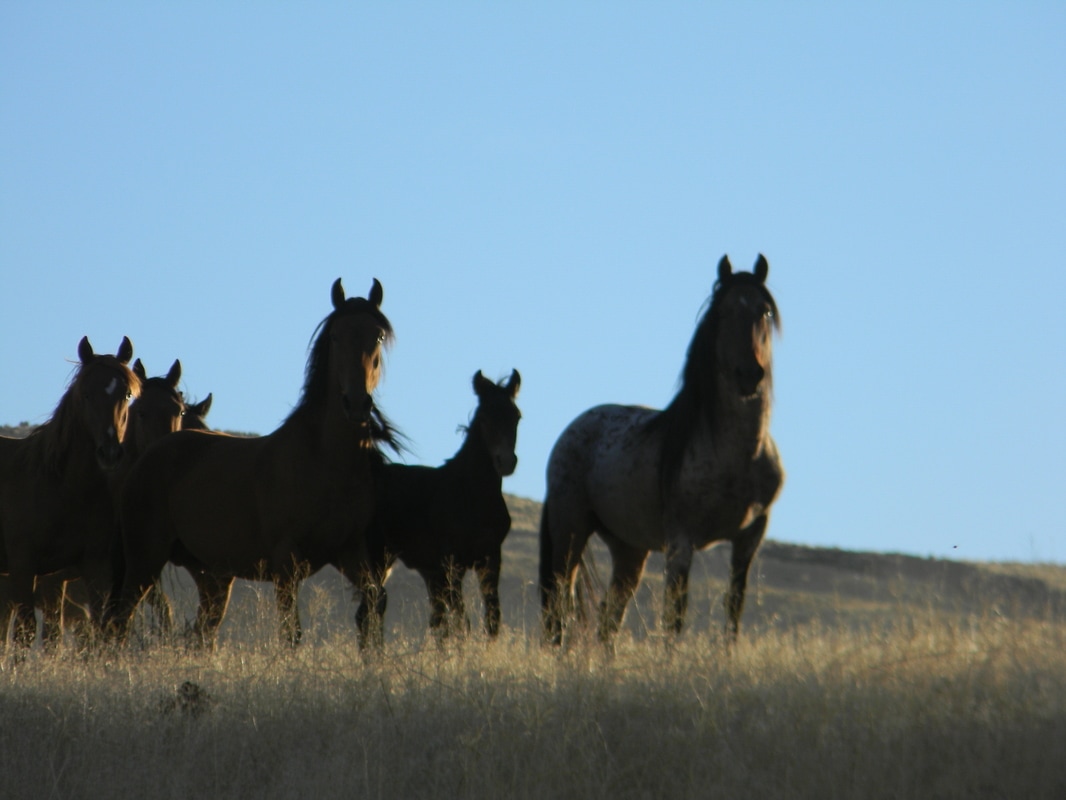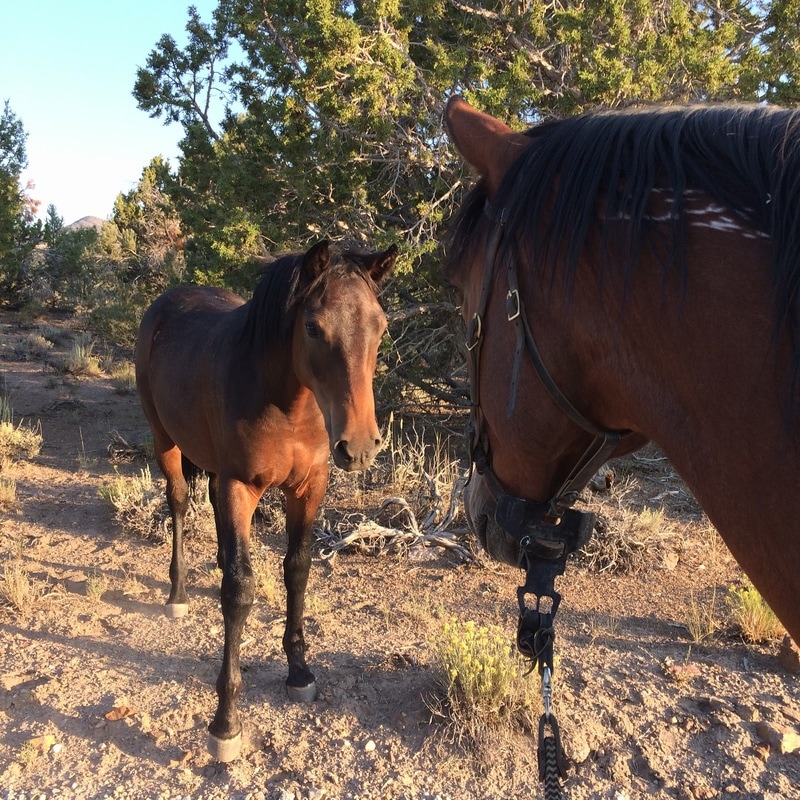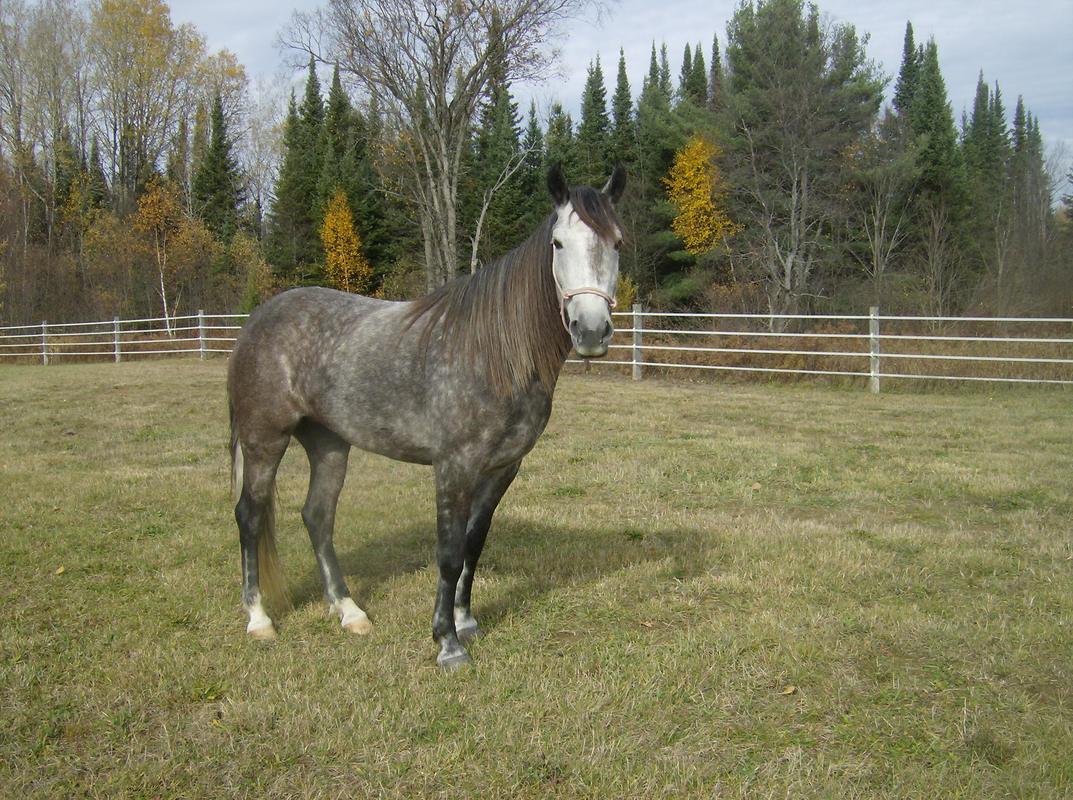WILD HEART MUSTANGS™ e-zine
|
This original print of a Grooming Burros, by Mary A. Lainhart is available for purchase in the SHOP.
|
Editor's Note: I had the privilege of attending a Donkey Welfare Symposium at Cornell University last Fall. Presenters at the Symposium were from across the globe. I attended to educate myself more about this often misunderstood animal. I was stunned to learn how unique donkeys/burros are from horses physiologically. Equally shocking is the lack of understanding, especially in the United States, about their diets, care and well-being. Overwhelmingly, it seems that donkey/burro owners are treating their animals as "horses with big ears", through no fault of their own. Unfortunately, this is not only unhealthy for your donkey/burro, it can be life threatening. If you are planning on adopting a wild burro from the Bureau of Land Management, or already have, this is a must read for the care of your animals. The BLM guidelines for feeding your burro when you take it home, are erroneous and can cause life long issues for your burro. Please take a moment to educate yourself, or pass this along to anyone you know with a donkey or burro, so they can have accurate information on nutritional needs and requirements.
DONKEY NUTRITION
by Dr. Karen Rickards, DVM - Donkey Sanctuary
|
Karen Rickards PhD, BVSc, MRCVS - Qualified as a veterinary surgeon from University of Bristol, UK 1994 and worked in equine practice for 4 years before undertaking a PhD in equine allergic airway disease at The Royal Veterinary College. Carried on working in this field as a post doc before taking up a lectureship in pharmacology at King's College, London. Started working at The Donkey Sanctuary in 2007. Main interest has always been lower airway inflammatory disease and the pharmacology of inflammation. Since working at The Donkey Sanctuary a new area of interest is pain recognition and its management in donkeys. |
Dr. Karen Rickards, DVM - The Donkey Sanctuary, UK
|
Donkeys (also called burros and asses) originate from the arid regions of the world and their digestive system is uniquely adapted to survive in this type of environment. Whilst we have moved donkeys into more temperate climates and modified their size and shape, their digestive system remains the same, so we need to be aware of this when deciding what products to feed. The feeding strategy that donkeys use in their natural environment is to increase the amount of time it takes for food to pass through the digestive tract (known as gut transit time), which enables them to extract sufficient nutrients from more fibrous feeds than horses and ponies would eat. Because they eat more fibrous feed, which takes more chewing, their food intake is lower than that of a pony of comparable size but for this strategy to be effective donkeys need to have a relatively constant supply of fibre passing through their digestive system, a process known as trickle feeding. So in essence they eat less food because it is more fibrous so requires more chewing time but retain it within their gut for longer so that they extract more energy out of it.
If we provide donkeys with a food source that is less fibrous so requires less chewing time they will be able to increase their intake but will still retain the feed within their guts for the same amount of time so will therefore extract more nutrients from this type of diet. In addition less fibrous feed will be higher in digestible energy (DE), which is the amount of energy in the feed that can be used by the donkey, so they will be able to extract even more energy from their diet. In their natural environment donkeys will walk large distances to seek out food however as most of our donkeys are kept as pets, the amount of exercise they do is usually minimal. So if we superimpose this onto a diet that we have provided, which is easier to chew and is higher in energy, it is easy to see how quickly we can over supply energy, which is not used and instead is laid down as fat.
If we provide donkeys with a food source that is less fibrous so requires less chewing time they will be able to increase their intake but will still retain the feed within their guts for the same amount of time so will therefore extract more nutrients from this type of diet. In addition less fibrous feed will be higher in digestible energy (DE), which is the amount of energy in the feed that can be used by the donkey, so they will be able to extract even more energy from their diet. In their natural environment donkeys will walk large distances to seek out food however as most of our donkeys are kept as pets, the amount of exercise they do is usually minimal. So if we superimpose this onto a diet that we have provided, which is easier to chew and is higher in energy, it is easy to see how quickly we can over supply energy, which is not used and instead is laid down as fat.
Comparison of donkeys in their natural habitat and those in a temperate climate with excessive amounts of easily digestible, high energy grass available.
Studies have been conducted comparing food intake and maintenance energy requirements for donkeys and ponies and these have shown that to satisfy appetite a donkey needs to eat between 1.3 – 1.8% of their body weight in dry matter (DM) per day. So an average sized, healthy, adult donkey weighing 200kg (440lb) would eat 2.6 - 3.6kg (5.7 – 7.9lb) of DM per day whilst a miniature donkey weighing 100kg (220lb) will only eat 1.3 - 1.8kg (2.9 – 4lb). This is lower than for a pony who will eat 2 – 2.5% of their body weight per day. The donkey also has lower energy requirements and these vary depending on the time of year. So in the summer their requirement is 8.7kcal DE/lb body weight but when it gets colder in the winter this increases to 10.3kcal DE/lb body weight. However this is still lower than a pony’s requirements, which are not affected by season (17.0 kcal DE/lb body weight). By knowing these requirements we can calculate what the energy value of the diet needs to be to satisfy appetite without over or under supplying energy, which comes out as 0.57 – 0.68 Mcal DE/lb DM assuming an appetite of 1.5% body weight. In comparison the energy value of the diet for a pony would be 0.76 Mcal DE/lb DM assuming an appetite of 2.25% body weight.
If you look at the energy content of most laminitis safe horse feeds and forage such as hay they will be in the order of 0.81 – 1.1 Mcal DE/lb DM so feeding these to appetite in healthy adult donkeys will definitely over supply energy. Therefore, the only way to feed a diet with an appropriate energy content is to base it on good quality straw products as these mimic most closely the natural diet being high in fibre and low in energy. There are a range of straw products available that vary in their energy content and digestibility. Oat straw has the highest energy content and digestibility followed by barley and then wheat; so, in general, the advice would be to feed a good quality barley straw however mixtures can be fed if the energy content of the diet needs to be adjusted up or down. Due to the highly fibrous nature of wheat straw care needs to be taken when feeding this to avoid the risk of impaction colic, particularly in donkeys with any sort of dental disease. Other straw crops are available, however the Donkey Sanctuary has no experience of feeding them. These include flax, millet, rye and soybean. Flax straw has low digestibility due to its highly fibrous nature so probably should be avoided. Millet has a higher energy content and digestibility than oat straw so would need to be fed with caution as it is likely to result in weight gain if fed ad lib, particularly if it is fed alongside hay and grass. Rye and soybean appear to have energy and digestibility levels comparable to oat and barley straw so may be suitable alternatives. The calcium to phosphorus ratio in soybean straw is very high, however, this should not cause a problem if a low calorie vitamin and mineral supplement is fed as part of the diet.
We have discussed the need to provide energy in the form of fibre, however, energy can be provided as carbohydrate (starch and sugars) and oil. Diets rich in non-structural carbohydrate (NSC eg. cereals such as oats and barley) should be avoided as studies have shown they increase the risk of gastric ulceration, hyperlipaemia and impaction colic. In addition they will be too high in energy so will result in weight gain and increase the risk of laminitis, a painful condition that donkeys may suffer with in silence due to their incredible stoicism. Being overweight further increases the risk of hyperlipaemia and can result in the development of insulin resistance, which will heighten the risk of laminitis. Often people think that by feeding equine senior mixes, they will be feeding low energy donkey safe products however it is likely that most of these will still be cereal based so will have high starch and sugar levels and lower levels of fibre compared to products marketed as high fibre pellets (fibre content of around 20% is ideal). In general a NSC content of less than 10% is ideal.
Grass is high in sugar so grazing needs to be restricted, which is done far more effectively by controlling the size of the paddock rather than the grazing time. Grass can even be a risk over winter as frosts will break open the internal structure of the plant releasing the sugars contained within making them more available to the donkey. Care should also be taken when feeding straw that contains large amounts of grain as this is equivalent to feeding a high calorie cereal diet and donkeys will do everything they can to seek out the grain. Hay can also be high in sugar (8-10%) so ideally late cut hay containing more stem than leaf should be fed as this is likely to be more fibrous and lower in sugar. This is particularly important if good quality straw is hard to come by and hay is your only fibre source. In these circumstances make sure that you don’t feed legume based hay such as alfalfa or clover or young, leafy grass hay. Sugar levels will also decay with time during storage, however the quality must still be good with no dust or molds that might result in respiratory disease. Whatever forage you feed it is advisable to get its nutritional content analysed so you can see exactly what you are feeding with respect to DE, NSC and fibre. Feed companies will often provide a forage analysis service so contact your local supplier.
Donkeys can either have their grazing restricted by limiting paddock size or by strip grazing along a fence line
Soya oil can be a useful energy source in certain circumstances. Care needs to be taken over palatability so it needs to be introduced gradually up to a maximum of 100ml per day for an average sized donkey (200kg). It should not be fed to donkeys with liver disease and consideration needs to be given to the risk of vitamin E deficiency in diets rich in oil. This can be managed by feeding a low calorie vitamin and mineral supplement.
In summary the most appropriate diet for a healthy adult donkey should be provided by straw, hay or restricted grazing and should satisfy appetite by feeding between 1.3% - 1.8% of the donkey’s body weight per day in an ad lib manner to enable trickle feeding. As a guideline straw should constitute 75% of the diet in the summer and 50% in the winter with hay or restricted grazing making up the balance. The donkey should also be provided with a low calorie vitamin and mineral supplement. Any dietary changes should be made gradually over a 4-6 week period to avoid digestive upset.
Donkeys with dental disease, that are under or overweight, pregnant or lactating or are suffering from medical conditions such as liver or kidney disease will require modifications to these guidelines.
Donkeys with dental disease, that are under or overweight, pregnant or lactating or are suffering from medical conditions such as liver or kidney disease will require modifications to these guidelines.
|
There is a tendency to treat donkeys as if they are small horses with big ears but donkeys are different! They differ both physically and in their behaviour. Millions of years ago donkeys and horses had the same ancestors, but they evolved to be very different species. Understanding these differences is of vital importance to the correct care and welfare of donkeys.
- The Donkey Sanctuary For more information from The Donkey Sanctuary on proper health and care of donkey (ass/burro) please visit:
The Donkey Sanctuary UK Health and Welfare Feeding and Nutrition Veterinary Care Worming Training |
Click on The Donkey Sanctuary picture above to be redirected to their website to obtain printable .pdf flyers and pamphlets for the proper care and well being of your donkey (burro/ass).
|
HOME ON THE RANGE - THE NEVADA DISCOVERY RIDE
by Samantha Szesciorka
|
Samantha is a former U.S. Army journalist and television news producer. She now works as a museum curator and historian. Samantha moved to Nevada in 2008 and quickly fell in the love with the state's abundance of public land and wild horses. She adopted a wild horse in 2011 and the two completed the 1st Nevada Discovery Ride in 2013, riding nearly 500 miles across central Nevada to encourage wild horse adoption. Samantha is a member of the Long Riders' Guild and vice president of the Natural Horsemanship Association of Northern Nevada. When she's not working, Samantha can be found exploring the Nevada backcountry.
Click on the Nevada Discovery Ride logo , to be re-directed to their website to learn more about this incredible long ride.
|
Ryan Powell (Samantha's husband), Samantha Szesciorka, Sage and Bella (front bottom left) after their completion of over 1,100 miles riding across Nevada to raise awareness and adoptions for the over 40,000 wild horses in BLM holding facilities.
Photo courtesy of Darice Holloway Massey |
|
Last year my horse Sage and I spent nearly three months exploring the Nevada backcountry as we traveled more than 1,100 miles together. As I have shared in previous articles, a long ride is an incredible way to bond with your horse and to get to know the land. Each day on the trail brings new surprises, scenic views, challenges, and experiences. For us, it also provided an opportunity to study wild horses and burros on the range.
Nevada has more wild horses than any other state - somewhere around 30,000 according to the Bureau of Land Management. It’s also home to approximately 2,500 wild burros. I did not keep an exact tally, but I suspect we saw several hundred horses and burros during our journey. Our route took us through quite a few Bureau of Land Management wild horse and burro herd management areas, and in them we had some incredible encounters. |
Sage and I watched wild horses grazing and traveling together in small bands. We saw incredible variety in them - roans, paints, bays, buckskins, and every other coat pattern imaginable. We saw horses with obvious draft influence, others much smaller. We saw elderly horses and young foals. We saw bands of two and bands of 20 or more. The horses we saw looked healthy and happy roaming the backcountry of Nevada. But, not all of our encounters were so benign.
People are often surprised to hear that wild horses were in fact our biggest wildlife challenge as we traveled. Wild horses can be extremely territorial and, even from miles away, know when a strange horse is moving through their area. It’s the stallions of course who defend the territory and that often presents as aggression. I believe Sage and I have been charged by more wild horses that anyone else in the world! We faced territorial stallions almost every day - on the trail, in camp, and most frequently, in the middle of the night.
|
Typically, once we were spotted the lead stallion would break away from his band and charge. As he got closer he would begin to circle us, snorting and stomping with his hooves to try to intimidate us. Sometimes he would bring a younger stallion or two as backup, and occasionally the whole band would come with him. One day in the Owyhee Desert (near the Idaho border), we were charged by nearly 50 horses, led by a very angry red roan stallion! It’s downright terrifying to be faced with even one stallion, let alone dozens, as they rear and roar and edge closer and closer.
|
|
Every time we faced off with wild horses I felt a wave of fear wash over me, but I had to force myself to overcome it so that I could protect Sage. My 100% effective wild horse deterrent is shockingly simple. I tied an ordinary plastic bag to the end of a short riding crop, which I carried in my saddle bags at all times. Of course Sage is desensitized to plastic bags, but wild horses are not. So with just one or two shakes of the crop, the distinctive sound and sight of the plastic bag made even the angriest of stallions turn tail and run away.
After a while the charges became less and less scary. You might say we became desensitized to them, particularly when the horses charged camp in the middle of night. I can’t count how many times I was awoken by the sound of thundering hooves and whinnying at 2:00am. I’d rush out of the tent trying to peer into the darkness with a flashlight only to catch glimpses of glowing eyes peering back. After several months though, I didn’t even bother to get out the tent - I would just unzip the door, lean out, and shake the plastic bag! |
Not all the horses we encountered were aggressive. Some ran away as soon as they spotted us and others remained indifferent to our presence. Early on in the journey we had a particularly heartbreaking encounter with one wild horse who had an altogether different reaction. While in camp one evening in the White Pine Range in eastern Nevada, I caught sight of a horse moving through the thick juniper trees nearby and slowly making his way toward us. When the horse got closer I was surprised to see it was a young colt!
|
Sage greeting his new friend, a young wild horse colt
|
The little horse couldn’t have been more than a yearling and I could see that he was covered in bite marks. When young male wild horses reach sexual maturity (typically at age 2 or older) they are ejected from their herd by the lead stallion. This ejection can be quite violent, as the young horses don’t want to leave willingly. As a result, there is usually a lot of biting and kicking from the lead stallion to “convince” them to leave. Judging by the wounds I saw, the young colt that wandered into our camp had very recently been kicked out of his herd.
It broke my heart to see him all alone, and it was obvious as he crept toward Sage that he was looking for a new herd. Though he clearly meant no harm, I reminded myself that it is best for wild horses to maintain a healthy fear of people. I felt bad, but I chased him off with the plastic bag. Later that night I was awoken by a sound. I sat up in my tent and looked out to see Sage and the young colt nuzzling each other over the fence line of Sage’s electric corral! I watched them for awhile in disbelief. Since they seemed to be enjoying each other’s company, I let them be and went back to bed. |
The next morning I woke up and the young horse was gone. We ate breakfast, saddled up, and Sage and I hit the trail. As soon as we got outside of camp the little colt came bounding out of the trees toward us! He ran right up to Sage and they nuzzled each other like old friends. Unsure of what to do, I moved Sage down the trail. But I was shocked when the wild horse joined us! He excitedly followed us down the trail for miles, evidently relieved to no longer be alone.
I was torn. I thought to myself that this little horse would probably follow us forever since he was so eager for companionship. But, I knew that the journey ahead be too arduous for him. Regardless, even if I wanted to take the horse with us, it is illegal to remove wild horses off public land. I was relieved after several miles when we finally came to a cattle guard and a fence line. Sage and I went through the gate, but I stopped the colt from coming through. Now separated by the fence line, the little horse began to whinny as he ran back and forth. It was heartbreaking to leave him behind, but I knew it was for the best.
It makes me feel better to know that I left the colt in an area with lots of grass and water, and more importantly, other wild horses. I’m confident that if he can hang in there for a while and toughen up, that he’ll be fine. I haven’t stopped thinking about him though, so this spring I’m planning to head back out to the White Pine Range and see if I can find him. I’m hoping to find him healthy and happy!
I was torn. I thought to myself that this little horse would probably follow us forever since he was so eager for companionship. But, I knew that the journey ahead be too arduous for him. Regardless, even if I wanted to take the horse with us, it is illegal to remove wild horses off public land. I was relieved after several miles when we finally came to a cattle guard and a fence line. Sage and I went through the gate, but I stopped the colt from coming through. Now separated by the fence line, the little horse began to whinny as he ran back and forth. It was heartbreaking to leave him behind, but I knew it was for the best.
It makes me feel better to know that I left the colt in an area with lots of grass and water, and more importantly, other wild horses. I’m confident that if he can hang in there for a while and toughen up, that he’ll be fine. I haven’t stopped thinking about him though, so this spring I’m planning to head back out to the White Pine Range and see if I can find him. I’m hoping to find him healthy and happy!
|
Our nearly three month journey was full of incredible up close encounters with wildlife, from pronghorn antelope to elk to coyotes. But by far, having the opportunity to see wild horses free on the range was the highlight. I spent countless evenings watching them through binoculars from camp, enthralled by their interactions with each other and how they moved around the landscape. I spent even more time defending my horse and camp from their territorial spirit! I’m so grateful to have had the chance to see them that way -- a powerful reminder that they really are living symbols of the historic and pioneer spirit of the West.
|
Other articles written by Samantha for Wild Heart Mustangs™:
March 2016 Issue - "On the Trail with the Nevada Discovery Ride"
April 2016 Issue - "6 Tips for Long-Distance Riding"
June 2016 Issue - "Wild Horses Find New Lives Behind Bars"
July 2016 Issue - "6 Things That Happen on a Long Ride"
August 2016 Issue - "Happy Trails to You, Until We Meet Again"
January/February 2017 Issue - "Tales from the Trail"
READER CONTRIBUTION
My late husband and I adopted a four year old mustang from the BLM adoption in Mercedes, TX 2011. After my husband passed away, I moved home to Canada and brought my beautiful mare with me. She originated from Conant Creek Wyoming. I absolutely love the mustangs and Gypsy Blu is the very best horse I have ever owned.
Adrienne G.
Canada
Adrienne G.
Canada
For more information on adopting a wild horse or burro from the Bureau of Land Management click here
For information on adopting a wild horse or burro from the Bureau of Land Management internet adoption, click here
For a Bureau of Land Management wild horse and burro Adoption Schedule click here
For information on adopting a wild horse or burro from the Bureau of Land Management internet adoption, click here
For a Bureau of Land Management wild horse and burro Adoption Schedule click here
THERE ARE CURRENTLY OVER 50,000 WILD HORSES AND BURROS IN HOLDING FACILITIES. THAT NUMBER CONTINUES TO GROW. CONSIDER ADOPTING ONE OF THESE INTELLIGENT, ATHLETIC, VERSATILE ANIMALS.
|
If you know anyone who would like to share a photo of their mustang, burro/donkey or mule - have them send it to [email protected]
We would love to have them. |

